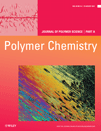Atom transfer radical polymerization synthesis and photoresponsive solution behavior of spiropyran end-functionalized polymers as simplistic molecular probes
Abstract
Poly(methyl methacrylate)s (PMMAs) of two different molecular weights having a single photochromic benzospiropyran (BSP) end-group were synthesized by atom transfer radical polymerization (ATRP). Polymer characterization by 1H NMR and matrix-assisted laser desorption/ionitiation time of flight-mass spectroscopy confirms that using an ATRP initiator equipped with BSP, a near quantitative functionalization of the PMMA with the BSP was achieved. Both polymers exhibit photochroism characterized by the UV-induced transition from BSP to benzomerocyanine (BMC) in acetonitrile. However, a strong molecular weight dependence of the thermal relaxation kinetic of the BMC was found with a significantly faster temperature-dependent transition for the higher molecular weight polymer. Thermodynamic analysis of the process revealed a higher gain in the entropy of activation ΔS± for the transition process in the higher molecular weight polymer. This suggests an energetically unfavorable nonpolar environment of the BMC group in the higher molecular weight polymers, although a higher solvation of the BMC in the lower molecular weight polymer contributes to its stabilization. The ability of the BMC polymer end-groups to organize was shown in metal ion-binding experiments forming bivalently linked complexes with Co ions. © 2011 Wiley Periodicals, Inc. J Polym Sci Part A: Polym Chem, 2011




